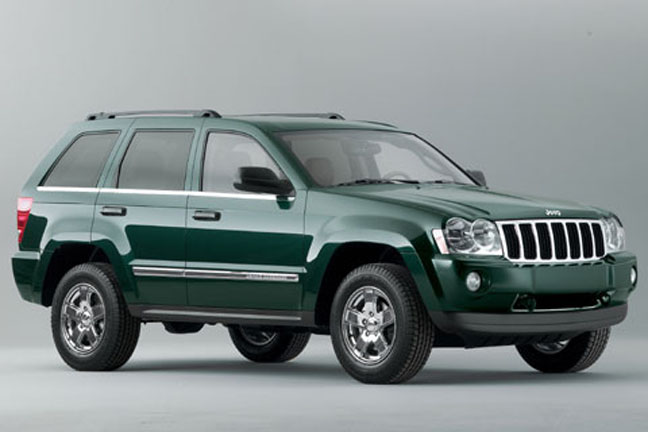Welcome to the JeepSpecs.com in-depth page on the 2005 WK Generation Jeep Grand Cherokee quality improvements. Did we miss anything? Please get in touch with us and tell us about it!
The 2005 Jeep Grand Cherokee blends past and future by evolving its heritage into a sophisticated and contemporary execution of an icon while using state-of-the-art technology to produce the highest quality vehicle possible.
“Quality is the lifeblood of any vehicle and company, but when that vehicle is a Jeep, all bars are raised,” said Stephen Walukas, Vice President, Corporate Quality. “Jeep owners know that quality has to be a priority if they are going to use their vehicle like no other sport-utility vehicle in the world.”
The 2005 Jeep Grand Cherokee was designed and engineered under the Chrysler Development System (CDS), the comprehensive, coordinated and disciplined product creation process that improves quality and speed-to-market while reducing costs and encouraging practical innovation in new products.
An emphasis in CDS is the systems engineering, design and up-front planning to avoid time-consuming and costly trial and error or changes during the latter phases of the product development cycle. With CDS, all product and process planning is completed and fully integrated before production tooling begins.
The system works: For Grand Cherokee alone, warranty repairs and expenses have been reduced by more than 60 percent in the past five years.
In external quality metrics, the Chrysler Group brands continue to make dramatic year-over-year improvements, prompting the results in one quality image survey, known as the Strategic Position Study, to show a four-percent improvement – more than any other manufacturer in the study.
The improvements in quality are reinforced with the 7-year/70,000 mile Limited Powertrain Warranty on the Jeep Grand Cherokee and other Chrysler Group products.
Development of the 2005 Jeep Grand Cherokee involved the work of hundreds of engineers along with the world-class testing facilities at the DaimlerChrysler Technology Center (DCTC) in Auburn Hills, MI, and proving grounds located in Michigan and Arizona. These engineers logged more than seven million miles of customer equivalent driving and experience in the vehicle.
The vehicle also benefited from a new $37 million Aero-Acoustic Wind Tunnel at the company’s Technology Center, which was completed in the summer of 2002, along with environmental simulators on site. Engineers had the opportunity to test early, full-size clay models more than 700 times to analyze various configurations of the design to make aerodynamic changes as well as to validate cooling and wind noise goals.
For example, dynamic sealing (essentially, weather strips) were strategically placed throughout the vehicle as a result of items learned during testing. Exact placement of the sealing included additional cut line coverage to decrease wind noise; lower coverage to decrease road noise; and, upper auxiliary seals improve water and wind management. In addition, an increased use of cavity foam and environmentally friendly water-borne sound dampening were applied in the body and paint sealing process at the manufacturing level as a result of the testing.
In fact, literally hundreds of hours were spent in test labs to minimize noise, vibration and harshness (NVH). In the area of wind noise, testing revealed many reduction enablers to assist in the design, NVH and engineering process. This included the ultimate shaping of mirrors, A-pillar geometry, thickness on side glass portions, and seals on the door glass runs and at the upper C-pillar and lift gate.
In addition to wind noise reductions, the team used extensive testing and data to refine the new Grand Cherokee’s powertrain, providing both hardware refinements and acoustic treatments. In particular, control of critical axle assemblies – such as ring and pinion mesh profiles that were selected for minimum gear noise – were key factors in NVH reductions. In addition, individual component and system balancing, as well as tightened tolerances on the rear drive shafts, were elements that were implemented early in the vehicle’s development.
Grand Cherokee vehicles underwent extreme body torsion and suspension articulation in tests such as “AK3”. AK3 is derived from the original test used to qualify Jeep vehicles for military use. Several of the new Grand Cherokee vehicles successfully completed back-to-back AK3 cycles. This helps to ensure that the new Grand Cherokee will meet or exceed customer durability and reliability requirements.
Four separate “Lap of America” trips were initiated during the phases of development to validate all aspects of vehicle performance to Jeep customer requirements. Trips from Detroit to all areas of the United States were taken to ensure the function of all systems under all ranges of customer use, including trailer tow and altitude testing.
Validation trips worldwide also were conducted from – 41 degrees Fahrenheit to 122 degrees Fahrenheit in such locations and conditions as:
| WK worldwide validation trips | |
| Chile | Cold weather validation and altitude test to 14,000 ft. |
| Manitoba, Canada | Cold weather validation |
| Sweden | Electronic Stability Program development/four-wheel drive system development |
| Switzerland | Mountainous durability testing |
| Death Valley, CA | Hot weather validation |
| Texas | Humid weather durability testing |
| Moab, UT | Off-road development/verification |
| Rubicon Trail, NV | Off-road development/verification |
| Daniel Boone National Forest, KY | Off-road development/verification |
All of these elements are proof that not only is there “one” Jeep, but one type of Jeep testing when it comes to quality: Extreme.

